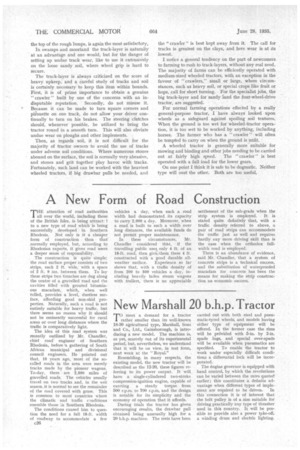A New Form of Road Construction
Page 76

If you've noticed an error in this article please click here to report it so we can fix it.
THE attention of road authorities all over the world, including those of the British Isles, is being attract: to a new type of road which is being successfully developed in Southern Rhodesia. Not only is it a cheaper form of construction than that normally employed, but, according to Rhodesian experts, it gives road users a deeper sense of responsibility.
The construction is quite simple; the road surface proper consists of two strips, each 2 ft. wide, with a space of 2 ft. 9 ins, between them. To lay these strips two trenches are dug along the centre of a gravelled road and the cavities tilled with grouted bituminous macadam, which, when well rolled, provides a level, dustless surface, affording good non-skid properties. Naturally, such a road is not entirely suitable for heavy traffic, but there seems no reason why it should not be eminently successful for rural areas or over long distances where the traffic is comparatively light.
The idea of this road system was recently outlined by Mr. Chandler, chief road' engineer of Southern Rhodesia, before % gathering of South African municipal and divisional council engineers. He pointed out that, 10 years ago, most of the socalled roads in the area were merely tracks made by the pioneer wagons. To-day, there are 2,500 miles of gravelled roads. The vehicles usually travel on two tracks and, in the wet season, it is normal to see the remainder of the road covered with grass. " This is common to most countries where the climatic and traffic conditions resemble those in Southern Rhodesia.
The conditions caused him to question the need for a full 18-ft. width of roadway to accommodate a few c26 vehicles a day, when such a road width had demonstrated its capacity to carry 2,000 a day. Moreover, when a road is built to such a width over long distances, the available funds do not permit proper maintenance.
In these circumstances, Mr. Chandler considered that, if the travelling public uses, only 4 ft. of an IS-ft. road, then give them these 4 ft. constructed with a good durable all weather surface. Experience so far shows that, with a traffic density of from 200 to 500 vehicles a day, including heavily laden steam wagons with .trailers, there is no appreciable settlement of the sub-grade when the strip system is employed. It is stated quite definitely that, with a traffic density referred to above, a pair of road strips can accommodate the traffic just as well and requires hardly any more driving skill than is the case when the orthodox fullwidth road is employed.
There is an abundance of evidence, said Mr. Chandler, that a system of concrete strips is a technical success, and the substitution of waterproofed macadam for concrete has been the means for making the strip construction an economic success.




























































































































































